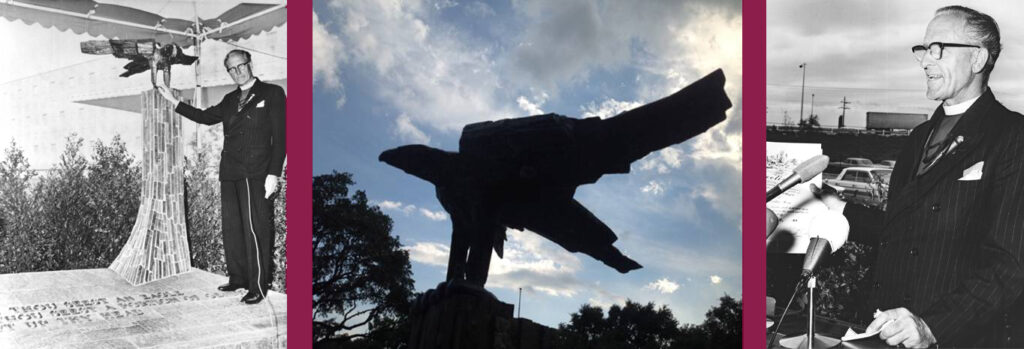
CovSoc member and Chair of the Friends of Coventry Cathedral, Martin Williams, has given permission for the reprint of this article from the latest edition of Chairman’s E News. Martin writes….
A casting of the eagle sculpture of Coventry Cathedral’s great lectern stands outside Dallas Trade Mart as a memorial to President Kennedy.
In Dallas USA, on the platform below the column on which the eagle is perched is written a phrase from a poem by William Blake: ‘When thou seest an eagle, thou seest a portion of genius. Lift up thy head.’
There is also a dedication plaque on which is written: ‘Placed in memorial by the friends of President John Fitzgerald Kennedy who awaited his arrival at the Dallas Trade Mart, November 22, 1963’.
The assassination of President Kennedy took place in Dealey Plaza, Dallas as he was on his way to give a speech to 2,600 people at a sold-out luncheon in the Grand Courtyard of Dallas Trade Mart. The Coventry Cathedral eagle was proposed as a suitable memorial for the President by Mr John Stemmons, the Chairman of Dallas Trade Mart, because it had so impressed him when he visited Coventry the previous year.
Bishop Cuthbert Bardsley blessed and dedicated the eagle during a service held at the memorial in October 1964. He paid tribute to President Kennedy as “a great leader”.

The Eagle was created by Elisabeth Frink (1930-93), pictured above left, and was her first major commission. Even while she was a student at Chelsea College of Art, Frink had an interest in the possibilities of sculpting animals. One of her earliest works, Bird, 1951, was purchased by the Tate Gallery.
The design for the Coventry Cathedral lectern evolved out of her previous bird works and studies she made of the birds at London Zoo. If you look carefully at it you see how in order to create the feathers, she set kindling sticks into the plaster with which she was working.
The Cathedral architect, Basil Spence, wrote that Elisabeth Frink… “has designed and carried out a magnificent bird which looks as if it has just settled there after a long flight”.
As far as I have been able to discover there were five castings made of the Eagle, though I have been unable to find out where they all are today. One Eagle (“Architect’s copy”) was made for Basil Spence. An Eagle sculpture came on the market in 2018 and was sold at auction for £440,750. On another occasion in an exhibition of Frink’s work there was an acknowledgment to “The Ingram Collection”.
Does anyone know where the other eagles have landed?
